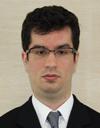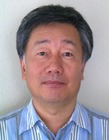 |
 |
 |
Professor |
Assistant Professor |
Visiting Researcher |
- Visualization of surface and volume data, which results from finite element, boundary element and finite difference modeling.
- Nanomechanics modeling. Finite element and molecular mechanics modeling of self-positioning micro- and nanostructures.
- Augmented reality interface for different fields of human activity.
- Using graphics processing units for physics-based modeling and animation.
- Development of algorithms for shape modeling, analysis and understanding (operations on shape, segmentation and reconstruction).
- Investigation of algorithms for the polygonization of implicit surfaces (adaptive and robust polygonization, fast polygonization).
The Computer Graphics Lab conducts research into physics-based modeling of different
phenomena, their visualization and animation. Innovative approaches to graphical user
interfaces and direct interaction methods, modeling, rendering, simulation and scientific
visualization are under development. Created mathematical models are used for
graphical representation of natural processes.
|
Refereed Journal Papers
| [niki-01:2009] |
Y.Nishidate and G.P.Nikishkov. Curvature estimate for multilayer rolledup
nanostructures with cubic crystal anisotropy under initial strains. Journal of
Applied Physics, 105:093536–1–6, 2009. |
| The generalized plane strain solution for anisotropic multilayer nanostructures with cubic
crystal symmetry under the influence of initial strains has been derived. This solution
can be used to estimate equilibrium curvature radius and strains/stresses of rolled-up
anisotropic multilayer nanostructures, whose deformations are induced by crystal lattice
mismatch. The solution has been applied for calculation of curvature radii and strain
components of a bilayer In0.2Ga0.8As/GaAs rolled-up nanostructure. The results are
in agreement with those obtained by a finite element analysis. |
Refereed Proceeding Papers
| [niki-02:2009] |
G.P.Nikishkov. Simple course management tool written in Java. In World
Conference on E-Learning in Corporate, Government, Healthcare, and Higher
Education (E-Learn 2009), page 64, Vancouver, Canada, 26–30 October 2009. |
| A simple course management tool (CMT) has been developed using Java and Web
technologies. The Java application runs on any computer and supports interaction
between an instructor, teaching assistants and students. It provides graphical user interface
and includes aWeb server, a mailer and a simple database. The HTTP protocol
is used for all communications. Both teachers and students employ Web browsers to
access the CMT server. Students have possibilities to check their personal data (scores
and comments), to download educational materials, to upload files and to communicate
to the instructor or teaching assistants. Main difference of the presented CMT
from available course management system is in simplicity of its learning, installation
and support. |
|
| [niki-03:2009] |
G.P.Nikishkov. Combined finite- and boundary-element analysis of SCC
crack growth. In Second International Symposium on Computational Mechanics
(ISCM II), page 6 pp., Hong Kong – Macau, 30 November – 3 December
2009. |
| Modeling of stress corrosion cracking (SCC) is performed using the combination of the
finite element method and the symmetric Galerkin boundary element method. The
uncracked structural component is represented with finite elements. The crack is simulated
using the boundary element method. The superposition principle is employed
for combining two solutions. The equilibrium state for the system of the structural
component and the crack is reached after several iterations that alternate between
two methods. It is adopted that the crack develops in the direction of the J-integral
vector and the crack growth rate is determined by the mechanochemical model using
the effective stress intensity factor based on the J-integral value. Results of SCC crack
growth modeling are presented for inclined semi-elliptical surface cracks under tensile
loading |
Books
| [niki-04:2009] |
G.P.Nikishkov. Programming Finite Elements in Java. Springer, London,
2010. |
| The book focuses on algorithms of the finite element method and their programming.
First, general equations of the finite element method for solving solid mechanics and
thermal conductivity problems are introduced. Then, algorithms of the finite element
method and their programming in Java are considered. In addition to solution methods,
the book presents algorithms and programming approaches for mesh generation and
visualization. |
Chapters in Book
| [niki-05:2009] |
V.Klyuev and G.P.Nikishkov. Using a Web-based system to support teaching
processes, pages 151–165. ICTs for Modern Educational and Instructional
Advancement: New Approaches to Teaching. IGI Global, Hersley, USA, 2009. |
| A platform-independent Java Web application TSI that supports communication between
an instructor, teaching assistants and students in a traditional on-campus course
is presented. Using the TSI, the instructor and teaching assistants can handle most of the
routine work: upload student personal information, send students personal emails, etc.
The system can easily be installed and administered individually by an instructor inexperienced
in computers. Students can check their personal data (scores and comments),
download educational materials, etc. |
Grants
| [niki-06:2009] |
Gennadiy Nikishkov. Tohoku Nuclear Cluster, 2009. |
Academic Activities
| [fayolle-03:2009] |
P.A. Fayolle, 2010.
Reviewer, Spring Conference on Computer Graphics |
| [fayolle-04:2009] |
P.A. Fayolle, 2010.
Reviewer, Computer Graphics International |
| [fayolle-05:2009] |
P.A. Fayolle, 2010.
Reviewer, International Journal of Computer Games Technology |
| [fayolle-06:2009] |
P.A. Fayolle, 2009.
Reviewer, Eurographics |
| [niki-07:2009] |
Gennadiy Nikishkov, 2009. Member of the Editorial Board, International Journal ’Computer Modeling in Engineering and Sciences’. |
| [niki-08:2009] |
Gennadiy Nikishkov, March 2010. Member of the Program Committee, Int. Conf. on Computational and Experimental Engineering and Sciences ICCES 2010, Las Vegas, USA. |
| [niki-09:2009] |
Gennadiy Nikishkov, October 2009. Member of the Program Committee, IEEE 9th International Conference on Computer and Information Technology (CIT 2009), Xiamen, China. |
| [niki-10:2009] |
Gennadiy Nikishkov, May 2009. Member of the Program Committee, International Conference on Computational Science (ICCS’2009), Baton Rouge, Louisiana, USA. |
| [niki-11:2009] |
Gennadiy Nikishkov, February 2010. Member of the Program Committee, IASTED International Conference on Computer Graphics and Imaging (CGIM 2010), Innsbruck, Austria. |
| [niki-12:2009] |
Gennadiy Nikishkov, 2009. Reviewer, Computers and Structures. |
| [niki-13:2009] |
Gennadiy Nikishkov, 2009. Reviewer, Engineering Analysis with Boundary Elements. |
Ph.D, Master and Graduation Theses
| [niki-14:2009] |
Takuya Inabe. Master Thesis: Particle-based water flow simulation on
GPU, University of Aizu, 2010.
Thesis Advisor: Gennadiy Nikishkov |
| [niki-15:2009] |
Yuichiro Suzuki. Master Thesis: Augmented reality system for trying on
glasses, University of Aizu, 2010.
Thesis Advisor: Gennadiy Nikishkov |
| [niki-16:2009] |
Ayaka Sugimura. Graduation Thesis: User interface for scientific data
visualization, University of Aizu, 2010.
Thesis Advisor: Gennadiy Nikishkov |
| [niki-17:2009] |
Ryuichi Ogata. Graduation Thesis: Shape modeling of eyeglasses, University
of Aizu, 2010.
Thesis Advisor: Gennadiy Nikishkov |
| [niki-18:2009] |
Akira Matsui. Graduation Thesis: Animations in augmented reality applications,
University of Aizu, 2010.
Thesis Advisor: Gennadiy Nikishkov |
| [niki-19:2009] |
Katsuya Mizushima. Graduation Thesis: Animation of 3D models using
Java, University of Aizu, 2010.
Thesis Advisor: Gennadiy Nikishkov |

2011 THE UNIVERSITY OF AIZU ALL RIGHTS RESERVED